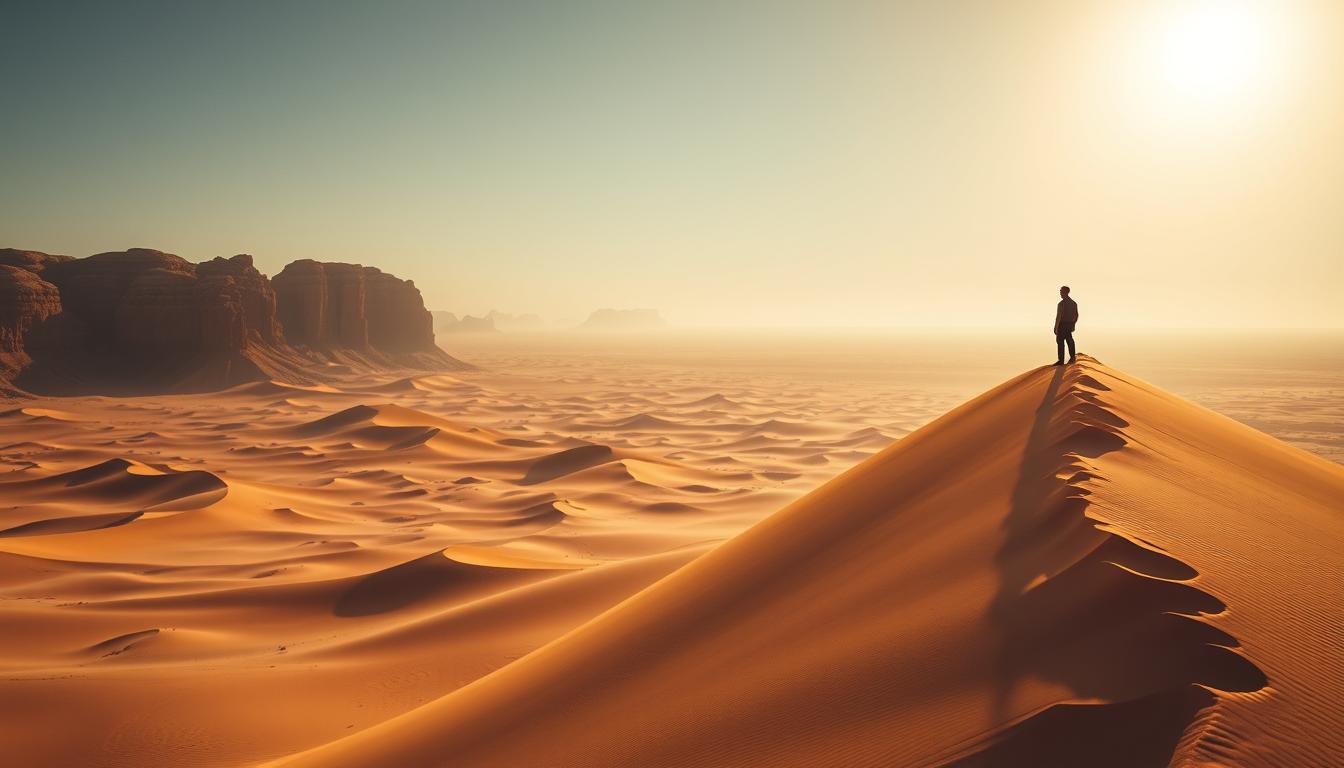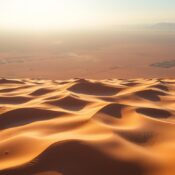
Capturing Sands: Tips for Desert Photography Dubai
The first time you stood on a dune, the desert seemed to breathe. The sky turned gold, and the sand looked like waves. In that moment, everything else vanished. Desert photography in Dubai brings out raw light, endless patterns, and unique moments.
Are you looking for solitude at dawn or the cool blues after sunset? These tips will help you plan. Safari Desert Dubai is your go-to for safe and legal photo shoots. They offer tours specifically for photographers. You can try Dune Buggy Tours, Quad Biking, and even Camel Rides.
Knowing the area is key. The dunes in the United Arab Emirates change with the season and time. They offer amazing light and many subjects, like wildlife or local scenes. You can book with Safari Desert Dubai anytime. Just call +971 52 447 2716 or email [email protected]. They help you find the best time to shoot, catching the desert in perfect light.
Key Takeaways
- Plan shoots around light: golden hour and blue hour are essential for dramatic results.
- Use Safari Desert Dubai for guided access and logistics to maximize shooting time.
- Book anytime — 24-hour booking ensures you can shoot at optimal hours.
- Expect shifting textures and varied subjects across the United Arab Emirates’ dunes.
- Combine vehicles, camels, and people to add scale and storytelling to images.
Tips for Desert Photography Dubai
Turning Dubai’s dunes into stunning photos needs a clear plan and a few easy tricks. Begin by finding spots near Dubai where the golden sands, salt flats, and few plants come together. Aim to shoot from November to March when it’s cooler for better light and longer sessions. For remote spots, consider hiring experts like Safari Desert Dubai for help with access and safety.
Why the Dubai desert is a unique photography destination
UAE’s dunes change color and shape with the sun, making stunning sculptures to study closely. It’s near the city, so you can mix city and desert shots in one go. There are cool contrasts—like wind-shaped sand, vehicle tracks, and tough plants. Remember, seasons affect wind and light, so plan your shot timing accordingly.
Planning your shoot: timing, permits, and local weather
The time you shoot affects the mood. Early morning brings crisp air and still winds, while late afternoon offers long shadows and warm light. If you’re thinking of flying a drone, check the rules with the GCAA. Also get permission for any commercial shooting. Pay attention to the wind forecast to steer clear of sandstorms, and plan shorter outings when it’s hottest.
Always carry water and sun protection. Let your guides know where you’ll be and think about transport like dune buggies for a safer and easier time moving around. Having extra batteries and protective gear for your equipment is smart, too.
Using golden hour and blue hour to your advantage
The golden hour makes the dunes look soft and warm. Lighting up sand grains from behind makes them shine. Try using different exposure settings to get both the bright and dark parts right. In the blue hour, switch to cooler colors and longer exposures. This lets you capture a calm mood and the stars at night.
Composition techniques for sweeping dune landscapes
Guide the viewer’s eye using natural lines like ridges or footsteps. Use the empty space around to show the desert’s vastness. Put interesting things like camels or a person where the lines of the photo meet to draw attention.
Search for patterns or contrasts in the sands to make your photos stand out. Starting with a close-up on textured sand adds depth. Adding people or cars helps show how huge the desert really is.
Gear and equipment essentials for professional desert photography
When you arrive in the dunes, you have one goal: to capture the beauty of the Dubai sands. Start with a simple checklist that considers both weight and protection. Choose essential desert photography gear that allows you to take pictures all day and in changing conditions.
Camera bodies and lenses suited for desert conditions
Go for weather-sealed camera bodies from Canon EOS R, Nikon Z, or Sony Alpha series to keep out dust. Full-frame sensors are great for capturing details in both bright skies and dark shadows. A wide-angle lens like a 16–35mm is perfect for large scenes, and a 24–70mm lens offers flexible options.
Don’t forget a 70–200mm lens for close-up dune pictures, and a 35mm or 50mm prime for sharp shots at dusk. This combination follows pro tips and keeps your gear ready for anything during long photo sessions.
Tripods, filters, and remote triggers for sharp images
Choose a strong carbon-fiber tripod that can stand firm against wind and sand. It should have a low center of gravity and spread-out legs. This will ensure your long exposure shots turn out well.
Take a circular polarizer to make the sky look deeper and reduce shine. Use graduated ND filters to even out the brightness between the sky and the dunes. ND filters are also great for blurring clouds or moving objects for impressive photos.
Remember to bring a remote trigger or intervalometer for clear, shake-free shots and cool time-lapses. Wireless remotes are really handy for quickly changing your shot setup.
Protective gear: dust covers, lens cloths, and camera bags
Use neoprene or silicone covers to keep your cameras dust-free during shoots. Keep silica gel packs in your camera bag overnight to pull away moisture. Choose a bag with separate sections to protect your lenses from damage.
Always have microfiber cloths, a bulb syringe, and a sensor-cleaning kit to keep your gear in top shape. A strong strap or harness is important to prevent your camera from falling while you’re moving around.
Backup power and storage: batteries, memory cards, and chargers
Take extra batteries and a good power bank with you. The desert heat and long shooting sessions use up battery power quickly. Swap out batteries to stay charged during the most important lighting conditions.
Bring fast, high-capacity memory cards and a safe place to store them. Transfer your photos to a sturdy SSD like the Samsung T7 or SanDisk Extreme every day to keep them secure. Don’t forget your chargers and adapters for recharging at places like Safari Desert Dubai.
- Tip: Set up your gear the night before and check everything works to avoid surprises in the morning.
- Tip: Carry extra seals and a toolkit for quick fixes while you’re out taking photos.
Creative techniques and best desert photography techniques
First, learn about light, motion, scale, and editing. Knowing these will help you feel brave when trying new shots at sunrise or night.
Working with light and shadow to emphasize dune textures
Use low-angle light for long shadows that show off dune shapes. Stay side-on to the sun to highlight textures. Backlighting makes for stunning silhouettes and detailed sand grains.
To keep highlight details, bracket your exposures. Use focus stacking for clear textures up close. These methods are key for top-notch desert photos every time.
Long exposures, motion blur, and capturing wind-blown sand
Neutral density filters help achieve slow shutter speeds in daylight, capturing moving sand or soft clouds. For quick sand movements, a fast shutter speed will do the trick.
Always protect your camera with lens hoods and have a cloth ready. Combining long exposures and quick snaps enriches your photo collection with professional desert imagery.
Incorporating people, camels, and vehicles for scale
Add people, camels, or Safari Desert Dubai Hummers for depth and story. Putting them near the horizon shows how big the dunes are. Emirati clothing adds cultural depth.
You can keep subjects still for a true-to-life look or blur them to show motion. These are great tips for meaningful desert photos in Dubai.
Post-processing tips for color grading and sand texture enhancement
Shooting in RAW captures more detail for editing. Be gentle with highlight recovery and clarity to keep the dunes looking natural without extra noise.
Adjust colors to enhance sunset hues or add drama to sunsets. Dodge and burn to play with light and shade. Targeted adjustments help refine shadows and textures without unwanted noise.
Think green when packing and charging gear for the desert. For eco-friendly tips, read this guide: eco-friendly desert photography.
| Technique | When to Use | Practical Tip |
|---|---|---|
| Low-angle side lighting | Golden hour, early morning or late afternoon | Shoot parallel to ridgelines to highlight texture |
| Backlighting | Sunrise or sunset with clear sky | Meter for highlights, expose for rim-lit sand grains |
| Long exposure with ND filter | Bright daylight or dynamic skies | Use tripod and remote release for sharp foreground |
| High shutter speed | Wind events, dune buggies, or sand bursts | Protect lens and clean front element between frames |
| Inclusion of people or camels | To provide scale and cultural context | Pose subjects near horizon and use wide focal lengths |
| RAW workflow and selective clarity | Post-processing on all desert scenes | Recover highlights, use local contrast sparingly |
Conclusion
To make your Dubai desert photos stand out, plan well and choose the right time. Shoot during the golden and blue hours. Keep your gear safe from the desert’s sand and heat. Bring important stuff like different lenses, extra batteries, and strong storage. These tips will help you take better pictures.
Capture the desert’s vastness and atmosphere by using creative techniques. Photos with camels, dune buggies, or simply a lone figure can tell a story. Enhance your shots with careful editing to bring out the best in every image. These tips aim to turn your good photos into unforgettable ones.
Need help while you’re there? Safari Desert Dubai can guide you to the best spots. They offer various experiences like Private and Overnight Safaris, Dune Buggy Tours, and more. Each activity offers a different view of the desert. Their expertise can make applying these photography tips easier.
To book or for more information, call +971 52 447 2716 or send an email to [email protected]. They’re available 24/7. Challenge yourself to capture the desert’s beauty. Use these tips and consider teaming up with Safari Desert Dubai for a safer, well-timed, and scenic photo shoot.
FAQ
What makes the Dubai desert a unique place for photography?
The Dubai desert has vast red-golden dunes, sculptural ridgelines, and salt flats. It changes color with the sun’s angle. Near the city, you can do urban and desert photography in one trip. Safari Desert Dubai offers access to cool spots, along with sunrise and sunset pickups.
When are the best times to shoot in the Dubai desert?
Shoot during golden hour for warm colors and cool shadows. Blue hour is great for serene vibes and star photos. Mornings have less wind and clearer air. Avoid summer’s heat and sand. Use November–March for longer shoots.
Do I need permits for commercial shoots or drone use in the Dubai desert?
Yes, you need permission for commercial shoots and drones. Authorities like the General Civil Aviation Authority handle drone permits. Safari Desert Dubai can help with permits and logistics for private or overnight shoots.
What camera bodies and lenses work best in desert conditions?
Pick weather-sealed cameras from brands like Canon, Nikon, or Sony to keep dust out. Use full-frame sensors for better images. Bring different lenses for landscapes and details. A 35mm or 50mm is good for low-light conditions.
What protective gear should I bring to protect equipment from sand and heat?
Use covers and sealed bags to protect your gear from sand. Clean lenses with microfiber cloths and sensor kits. Wear a sturdy strap or harness. Carry sun protection and water for yourself.
Which tripod, filters, and accessories are essential for desert shoots?
Use a carbon-fiber tripod that stands up to wind. Bring ND filters for bright skies and polarizers for deep skies. Remote triggers reduce shake. Extra lens hoods protect from sand.
How many batteries and memory cards should I carry for a full-day or overnight safari?
Bring lots of batteries and memory cards. You’ll need them as power drains quickly. Consider a portable charger and high-speed cards. Also, use a portable SSD like Samsung T7 for backup.
How do I compose stronger images of sweeping dune landscapes?
Use lines like dune ridges to direct the eye. Play with space to show vastness. Use the rule of thirds for interest. Textured sand can add depth.
What exposure and metering strategies work best in high-contrast desert scenes?
Bracket exposures to catch a wide range of light. Use exposure compensation and the right metering mode for your subject. Shooting RAW helps fix tones in post-processing.
How can I capture wind-blown sand or motion creatively?
ND filters and long exposures make motion blur. High shutter speeds capture sand particles. Protect your lens and clean regularly. Mix these methods for dynamic stories.
How do I incorporate people, camels, or vehicles to communicate scale and narrative?
Position subjects at various distances to show scale. Shoot silhouettes or action for drama. Vehicles and camels give cultural context and help show the desert’s size.
What post-processing tips help enhance desert colors and textures?
Always shoot RAW. Adjust highlights and white balance. Use clarity on dune ripples and dodge and burn to shape light. Split toning adds mood with warm and cool tones.
Can I shoot stars and nightscapes during an overnight desert safari?
Yes, overnight safaris are great for stars due to low light pollution. Use wide-aperture lenses and balance the sky with foreground light. Safari Desert Dubai offers safe spots for this.
How does Safari Desert Dubai support photographers on shoots?
They offer tours and safaris, help with pickups, and give advice. They handle logistics for gear and permits. Contact them for booking and planning your shoot.
What safety precautions should I take when shooting in the desert?
Drink water, use sun protection, and share your plan with guides. Watch the weather and secure your gear. Follow your guide’s advice in sensitive areas.
Any final practical packing recommendations for a Dubai desert photo shoot?
Bring sealed cameras, various lenses, and a sturdy tripod. Have enough batteries, chargers, and memory cards. Pack for sun protection and hydration. For overnight, take warm clothes and power for your gear.


